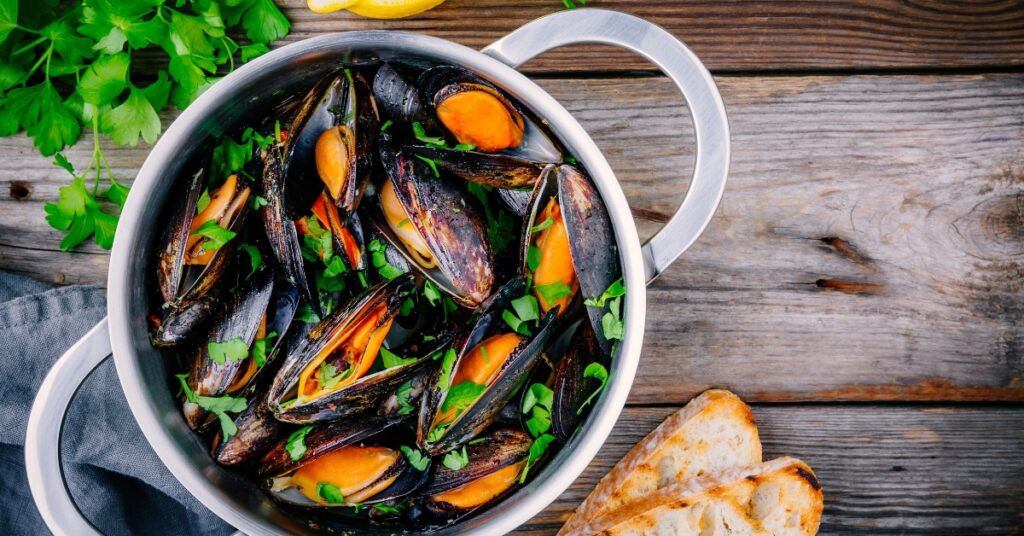Best Foods for Better Brain and Mental Health

As a fitness pro, you have probably fielded questions from your clients about “eating better”. They might ask things like, “Should I eat less carbs?” or “Should I eat more protein?” You are probably asked less often which foods help support brain and mental health, but this could be part of the conversation. What should your clients eat for optimal body and mind nutrition? The answer might surprise you. Mussels and oysters, anyone?
Eating for better brain and mental health
Here is why seafood should be on the menu more often: it contains nutrients that are good for the brain and protect against depressive disorders.
A few years ago, researchers at the University of Toronto and the Columbia University College of Physicians and Surgeons studied which foods have the highest density of nutrients known to play a role in the prevention and promotion of recovery from depressive disorders. (They defined nutrient density as “the ratio of a food’s nutrient value to its caloric content.”) Their study was published in the World Journal of Psychiatry in September 2018.
Here is what they found. By conducting a systematic literature review (a study of other studies), the researchers created a list of 12 “antidepressant nutrients” which are:
- Folate
- Iron
- Long-chain omega-3 fatty acids (EPA and DHA)
- Magnesium
- Potassium
- Selenium
- Thiamine
- Vitamin A
- Vitamin B6
- Vitamin B12
- Vitamin C
- Zinc
The researchers then compiled a list of foods with high content of at least one of these nutrients, based on the USDA database, and gave them an Antidepressant Food Score (AFS). The highest-scoring foods? Bivalves, including oysters and mussels, various seafoods and organ meats were tops among animal foods. Leafy greens, lettuce, peppers, and cruciferous vegetables scored highest for plant foods.
How much seafood should we eat?
Fish and seafood provide essential nutrients including omega-3 fatty acids (DHA and EPA), vitamin D, vitamin B12 and selenium. DHA and EPA may help lower the risk of cardiovascular disease and reduce inflammation. Low levels of DHA in the body and brain have been linked to cognitive impairment (more research is needed in this area).
Health Canada recommends eating at least two seafood meals per week, but most Canadians eat far less. I recommend enjoying fish, mussels, and other seafood more often. In Canada’s Food Guide, they fall into the category of “protein foods”. The guide recommends either canned fish with little to no added sodium, or fresh or frozen fish and shellfish that is not battered, breaded, or deep-fried.
In Canada, we are fortunate to be able to “eat local” when it comes to seafood—we produce high-quality seafood that is prized the world over. Prince Edward Island supplies 80% of the mussels in Canada. Mussels are also produced in Newfoundland and Labrador, Nova Scotia, and Quebec.
Eat more mussels
You may be more familiar with fish and shrimp than mussels. Do not overlook these humble shellfish—mussels are packed with vitamin B12 and the omega-3 fatty acid DHA, which are both good for your brain.
But what about mussels’ reputation as “bottom feeders”? Mussels filter and clean the waters where they grow—they draw in sea water and filter out the plants and plankton. They also extract CO2 from the ocean to build their shells.
Mussels are considered a sustainable food choice. The Environmental Defense Fund in the U.S. highlights several kinds of mussels among its eco-friendly best choices for seafood, and mussel farming is endorsed by several other environmental groups.
Making room for antidepressant foods
If fish and seafood are not already a regular part of your diet, how do you make room for two or more meals a week?
Research has shown that Canadians get nearly half (46%) of their calories from ultra-processed foods, including fast food and supermarket staples like breakfast cereals, baked goods, frozen pizza, processed meats, sweetened yogurt, chips, soft drinks, candy, etc. These products tend to be high in fat, salt, sugar, and calories, and low in fibre and nutrients. Cutting back on them in favour of unprocessed and minimally processed plant and animal foods, including fish and seafood, is a great first step toward a healthier diet.
How to buy, store and prepare mussels
- At your local seafood counter, you can find mussels sold in bags, trays or loose on ice. They should smell fresh and salty. Look for a tag that tells you where they are from and when they were harvested, along with nutritional information (or ask the vendor).
- If serving mussels as a main course, you will need 1 to 1¼ pounds per person. If it is an appetizer, about half a pound per person.
- If you are not preparing the mussels right away, cover them in ice and store them in the fridge at 34F to 38F. Drain the water daily to avoid drowning the mussels. Stored properly, they can live up to 14 days after harvesting.
- To prepare mussels, first place them in a clean and empty sink and inspect them. Discard any with a broken or cracked shell. (If you find one that is partially open, give it a tap—if it closes, you can still cook it.)
- To cook, steam mussels with water or white wine. Use a wide pot or pan—they will cook more evenly in a single layer. Divide the mussels into batches, if necessary. Discard any mussels that have not opened once cooked.
| Weight | Liquid | Approx. Cooking Time |
| 1 lb. | ¼ cup | 4-5 minutes |
| 2 lb. | ½ cup | 5-6 minutes |
| 5 lb. | ½ cup | 6-8 minutes |
Source: The Social Shell

